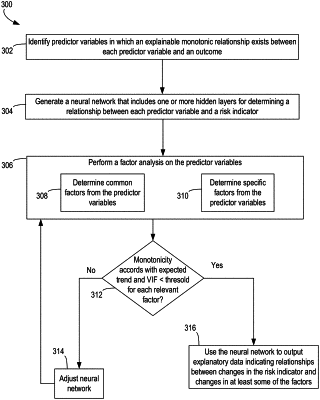| CPC G06N 5/045 (2013.01) [G06N 3/04 (2013.01); G06N 3/082 (2013.01); G06N 20/00 (2019.01); G06Q 40/03 (2023.01)] | 20 Claims |

|
1. A system comprising:
a processing device; and
a memory device in which instructions executable by the processing device are stored for causing the processing device to:
determine, using a neural network, a risk indicator for a target entity from predictor variables associated with the target entity by providing the predictor variables as input to the neural network, wherein the risk indicator indicates a level of risk associated with an entity,
wherein a monotonic relationship exists between (a) each common factor among common factors of the predictor variables determined via a factor analysis performed on the predictor variables and (b) the risk indicator as determined by the neural network and a value of the risk indicator increases as a value of the common factor increases or the value of the risk indicator decreases as the value of the common factor increases, and
wherein each common factor is a single variable indicating a respective relationship among a respective subset of the predictor variables; and
output explanatory data generated using the neural network, the explanatory data indicating relationships between (i) changes in the risk indicator and (ii) changes in at least some of the common factors.
|